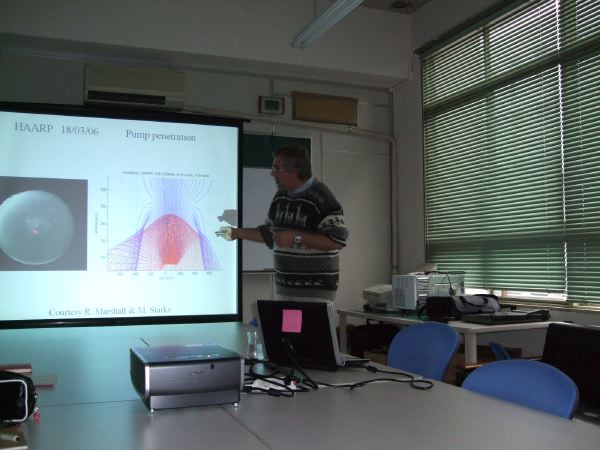|
|
| Mike Kosch先生 (滞在期間 H22.1.4 - H22.5.31) |
研究課題名:EISCATレーダー、光学観測機器、ロケット搭載観測器を用いた極域超高層大気の研究
研究計画概要:北極域超高層大気に間する研究を、EISCATレーダー、FPI、およびロケット実験により行う。具体的には、(1)EISCATレーダーおよびFPI観測によるF領域中性風、(2)EISCATヒーターおよび、FPIを用いた、エネルギー収支の研究、(3)EISCATレーダー、EISCATヒーター、FPIを用いた、酸素イオン上昇流の研究、(4)EISCATヒーターおよび光学観測機器により人工オーロラの研究、(5)デルタロケット2キャンペーンによる極域下部熱圏の研究、などを実施する。 |
 |
セミナー 平成22年1月12日午後2時から 309セミナー室にて。
Title: The study of wave-plasma resonances using artificial aurora experiments
in the ionosphere
Abstract:
High-power high-frequency radio waves beamed into the ionosphere with O-mode polarization cause wave-plasma interactions such as upper-hybrid resonance and Langmuir turbulence, which can accelerate electrons to high energies. These electrons collide with the atmospheric neutrals causing artificial optical emissions identical to the natural aurora. The brightest optical emissions are O(1D) 630 nm, with a threshold of ~2 eV, and O(1S) 557.7 nm, with a threshold of ~4.2 eV, but the N2+ 427.8 nm emission, with a threshold of ~18.6 eV, as well as many other wavelengths have been observed. The optical emissions give direct evidence of electron acceleration by wave-plasma resonance, as well as their non-Maxwellian energy spectrum. The experimental evidence collected over the past few years from the HAARP and HIPAS (Alaska), EISCAT and Sura (Russia) facilities is reviewed along with plans for the new Arecibo (USA) facility as well as the upcoming EISCAT campaign.
|
|
|

